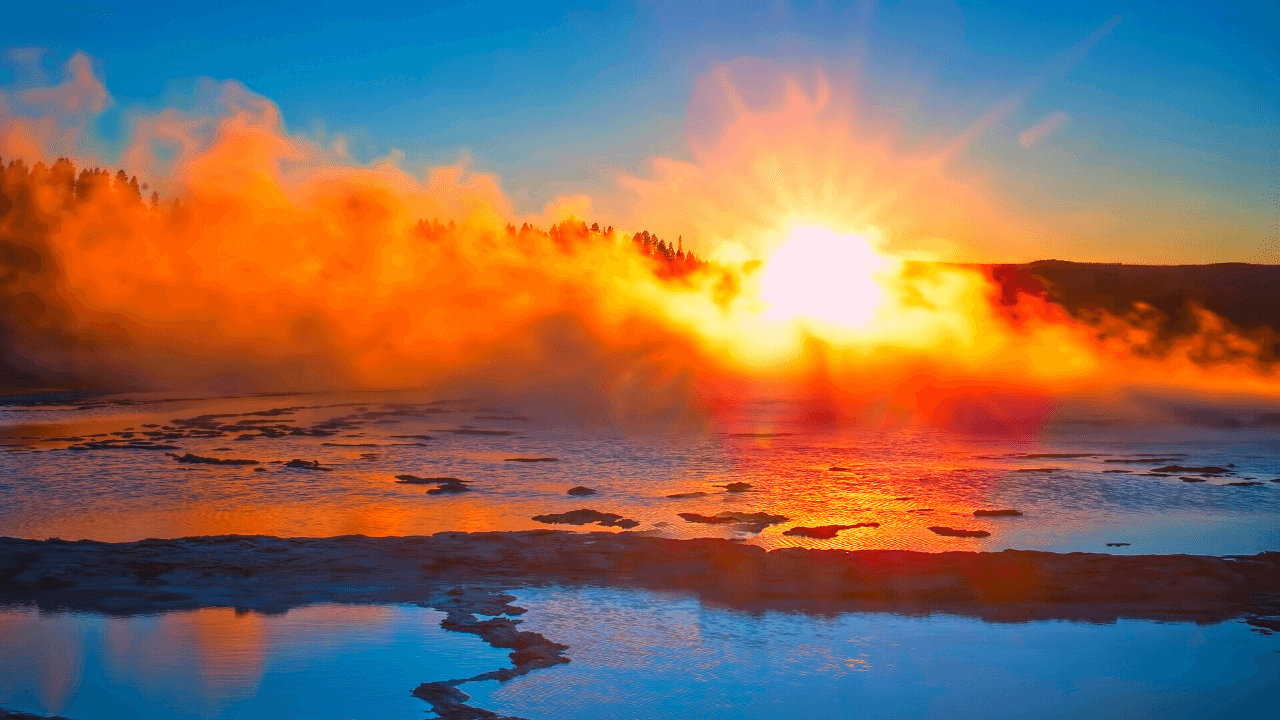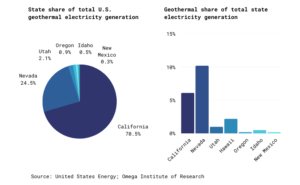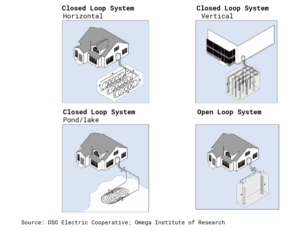- Industries
Industries
- Functions
Functions
- Insights
Insights
- Careers
Careers
- About Us
- Sustainability
- By Omega Team

Geothermal energy is the heat generated in the earth’s crust since the formation of the earth. The heat and pressure cause some rocks in the mantle to melt and convect upward since it is lighter. The temperature of the core-mantle boundary can reach more than 7,200 °F.
The use of geothermal energy dates back to the use of hot springs during the Paleolithic period. Now geothermal electricity generation has attracted people’s attention. Theoretically, geothermal energy is sufficient to meet human energy needs, although only a small proportion has been exploited.
Geothermal Electricity Generation
Geothermal power plants use hydrothermal resources that have both water (hydro) and heat (thermal). Geothermal power plants require high- temperature (300°F to 700°F) hydrothermal resources that come from either dry steam wells or from hot water wells. People use these resources by drilling wells into the earth and then piping steam or hot water to the surface. The hot water or steam powers a turbine that generates electricity. Some geothermal wells are as much as two miles deep. There are three basic types of geothermal power plants:
Dry steam plants use steam directly from a geothermal reservoir to turn generator turbines. The first geothermal power plant was built in 1904 in Tuscany, Italy, where natural steam erupted from the earth.
Flash steam plants take high-pressure hot water from deep inside the earth and convert it to steam to drive generator turbines. When the steam cools, it condenses to water and is injected back into the ground to be used again. Most geothermal power plants are flash steam plants.
Binary cycle power plants transfer the heat from geothermal hot water to another liquid. The heat causes the second liquid to turn to steam, which is used to drive a generator turbine.
The United States leads the world in the amount of geothermal electricity generation. As a result of government-assisted research and industry experience, the cost of generating geothermal power decreased by 25% over the 1980s and 1990s. In 2020, there were geothermal power plants in seven states, which produced about 17 billion kilowatt-hours (kWh), equal to 0.4% of total U.S. utility-scale electricity generation.
Figure 1: States with Geothermal Plants in 2020

Healing and Cooling Buildings
Geothermal Heat Pumps
Geothermal heat pumps (GHPs) have been in use since the late 1940s. They use the constant temperature of the earth as the exchange medium instead of the outside air temperature. A few feet below the earth’s surface, the ground remains at a relatively constant temperature. Depending on latitude, ground temperatures range from 45°F to 75°F. Like a cave, this ground temperature is warmer than the air above it during the winter and cooler than the air in the summer. The GHP takes advantage of this by exchanging heat with the earth through a ground heat exchanger. Even though the installation price of a geothermal system can be several times that of an air- source system of the same heating and cooling capacity, the additional costs are returned to you in energy savings in 5 to 10 years. System life is estimated at up to 24 years for the inside components and 50+ years for the ground loop. There are approximately 50,000 geothermal heat pumps installed in the United States each year.
There are four basic types of ground loop systems. Three of these are closed-loop systems. The fourth type of system is the open-loop option. Which one of these is best depends on the climate, soil conditions, available land, and local installation costs at the site. All of these approaches can be used for residential and commercial building applications.
Most closed-loop geothermal heat pumps circulate an antifreeze solution through a closed-loop -usually made of plastic tubing- that is buried in the ground or submerged in water. A heat exchanger transfers heat between the refrigerant in the heat pump and the antifreeze solution in the closed-loop. The loop can be in a horizontal, vertical, or pond/lake configuration.
Horizontal loop is generally most cost-effective for residential installations, particularly for new construction where sufficient land is available.
Vertical loop is often used in large commercial buildings and schools because the land area required for horizontal loops would be prohibitive. Vertical loops are also used where the soil is too shallow for trenching, and they minimize the disturbance to existing landscaping.
Pond/Lake loop can only be placed in a water source that meets minimum volume, depth, and quality criteria. A supply line pipe is run underground from the building to the water and coiled into circles at least eight feet under the surface to prevent freezing. If the site has an adequate water body, this may be the lowest cost option.
Open-Loop system uses well or surface body water as the heat exchange fluid that circulates directly through the GHP system. This option is practical only where there is an adequate supply of relatively clean water, and all local codes and regulations regarding groundwater discharge are met.
Figure 2: Types of Geothermal Heating Systems

Geothermal Air Conditioner
The heat transfer process works in reverse. As air is circulated through the house, the heat pump removes heat from the air and transfers it to the fluid that circulates to the ground. As the ground is at a lower temperature (55F), heat dissipates from the fluid to the ground. The experience of cold air blowing into your home is the result of the process of removing heat from the circulated air, transferring that heat to the ground, and returning cool air back to your home.
Geothermal AC has many advantages over conventional AC. It is more energy-efficient, costs less in the long term, and is quieter. Geothermal AC beats conventional central AC by far inefficiency. Energy Efficiency Ratio (EER) represents the ratio of energy input to energy output, with higher EER representing greater efficiency. A Heating, Ventilation, and Air Conditioning (HVAC) system with an EER of 3.4 is at the break-even point, where it produces as much energy as it requires. Typically, Geothermal AC systems have EERs between 15 and 25, while even the most efficient conventional AC systems only have EERs between 9 and 15.
Conventional central air conditioning systems tend to have a lower upfront cost but higher operational costs. It typically lasts between 12 to 15 years. Often, the main components significantly degenerate within the first 5 to 10 years, causing a steady decline in efficiency. The installation cost of geothermal AC is more expensive, but in the end, it usually works out to be much more affordable than conventional AC. A geothermal cooling system pump lasts well over 20 years, and the underground looping system lasts well over 50 years. In addition, conventional AC is known to be noisy, while geothermal AC systems are much quieter because they direct hot indoor air into the cool ground.
Advantages and Disadvantages
Geothermal energy is more environmentally friendly than conventional fossil fuels. Geothermal plants have a very low carbon footprint. While some pollution is related to geothermal plants, it pales in comparison to fossil fuels. It is a reliable source of energy that will continue to be produced as long as the Earth exists. The hot reservoirs within the Earth are naturally replenished, making it both renewable and sustainable. Unlike wind and solar energy, its resource is always available to be tapped into.
There is huge potential for the growth of geothermal energy production. More hot reservoirs will be put into use as research and development for the industry continues. World energy consumption is currently about 15 terawatts, and geothermal plants are estimated to provide between 0.0035 and 2 terawatts. There is a great deal of exploration into geothermal energy at the moment, meaning that new technologies are being created to improve the energy process. There is an increasing number of projects to improve and grow this area of industry. With this rapid evolution, many of the current cons of geothermal energy will be mitigated.
The largest single disadvantage of geothermal energy is that it is location-specific. Geothermal plants need to be built in places where the energy is accessible, which means that some areas are not able to exploit this resource. Geothermal energy is an expensive resource to tap into, with price tags ranging from around $2-$7 million for a plant with a 1-megawatt capacity. However, where the upfront costs are high, the outlay can be recouped as part of a long-term investment.
In order to maintain the sustainability of geothermal energy, fluid needs to be pumped back into the underground reservoirs faster than it is depleted. This means that geothermal energy needs to be properly managed to maintain its sustainability.
In addition, the use of geothermal energy will bring some environmental side effects. During excavation, some of the greenhouse gases stored underground are released, but the amounts of these gases are small in comparison to the burning of fossil fuels. The excavation also carries the threat of causing earthquakes. This problem is more prevalent with enhanced geothermal power plants, which force water into the Earth’s crust to open up fissures to greater exploitation of the resource. However, since most geothermal plants are away from population centers, the implications of these earthquakes are relatively minor.
Overall, the problems associated with the use of geothermal energy seem entirely acceptable compared to its advantages. It remains a good sustainable energy option with a high rate of return.
Conclusion
Geothermal energy is an efficient, clean, and stable energy source. It is a good alternative to fossil fuels for electricity generation, and for heating and cooling systems that last longer and are more energy- efficient than conventional ones. Some countries are already using geothermal energy to generate electricity on a large scale. In the United States, it is concentrated in the central and western regions. The use of geothermal energy is restricted by location, but it is still a promising energy source because plenty of hot reservoirs still remain untapped.
Subscribe
Select topics and stay current with our latest insights
- Functions